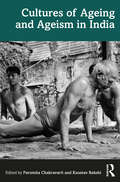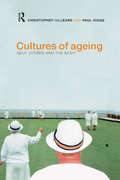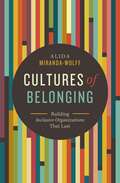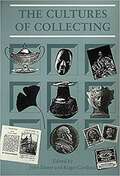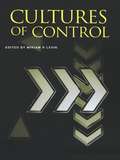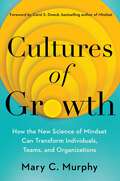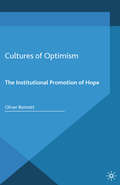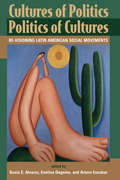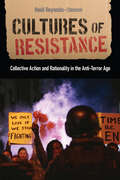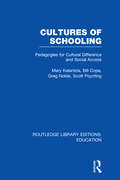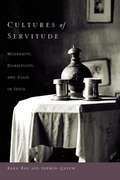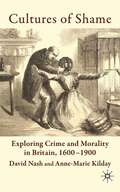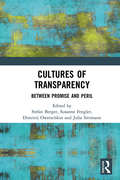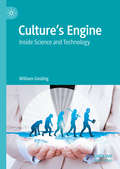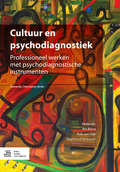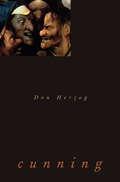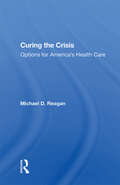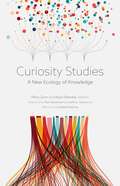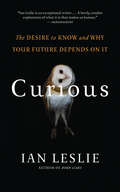- Table View
- List View
Cultures of Ageing and Ageism in India
by Paromita Chakravarti and Kaustav BakshiThis book examines the discourses on ageing and ageism in Indian culture, politics, art and society. It explores its representations and the anxieties, fears and vulnerabilities associated with ageing.The volume looks at ageing within the contexts of the larger discourses of gender, sexuality, nation, health and the performance and politics of ageing. The chapters grapple with diverse issues around ageing and elder care in contemporary India, shifts in socio-economic conditions and the breakdown of the heteropatriarchal family. The book includes personal accounts and narratives that detail the daily experiences of ageing and living with disease, anxiety, loneliness and loss for both elders and their friends and families. The book also explores the models of alternative networks of kinship and care that queer elders in India create in India as well as examining narratives—in society, art, sports and popular culture that both critique and challenge stereotypical ideas about the desires, aspirations, and mental and physical capabilities of elders.Topical and comprehensive, this book will be useful for scholars and researchers of gerontology, literature, cultural studies, popular culture, sociology, social psychology, queer studies, gender studies, social anthropology, and South Asian studies.
Cultures of Ageing: Self, Citizen and the Body
by Chris Gilleard Paul HiggsFor undergraduate courses in sociology and psychology which examine ageing adulthood. This book focuses on the dramatic changes to the nature of post-retirement life experienced by people at the end of the twentieth century. It examines age and ageing in terms of the key preoccupations of contemporary sociology - citizenship, the body and the self. The book provides a platform for a new social gerontology that sees ageing as central to our understanding of social change. It examines social, cultural and political changes in Europe and North America to address the need for a text that moves the study of ageing from social policy towards the mainstream of social science.
Cultures of Belonging: Building Inclusive Organizations that Last
by Alida Miranda-WolffClear, actionable steps for you to build new values, experiences, and perspectives into your organizational culture, infusing it with the diversity, inclusion, and belonging employees need to feel accepted, be their best selves, and do their best work.Bypass the faulty processes and communication styles that make change impossible in so many other organizations; access these practical tools and ideas for increasing diversity, equity, and inclusion (DEI) in your company.Filled with actionable advice Alida Miranda-Wolff learned through her own struggles being an outsider in a work culture that did not value inclusion, and having since worked with over 60 organizations to prioritize DEI initiatives and all the value and richness it adds to the workplace, this roadmap helps leaders:Learn why creating an environment where everyone feels belonging is the new barometer for employee engagement.Develop an understanding of the key terms around DEI and why they matter. Assess where your organization is today.Define and take the small steps that build new muscle memory into an organizational culture.Increase employee engagement, collaboration, innovation, communication, and sense of belonging.Build confidence in how to solve future DEI-related challenges.Get buy-in from colleagues (and even resisters) who can clearly see how to move forward and why.Overcome any limiting work environment and build all new processes and communication priorities that allow your employees to be a part of something greater than themselves while your organization learns to value and embrace the unique experiences and perspective that each employee brings to the company.
Cultures of Charity: Women, Politics, and the Reform of Poor Relief in Renaissance Italy
by Nicholas TerpstraRenaissance Italians pioneered radical changes in ways of helping the poor, including orphanages, workhouses, pawnshops, and women’s shelters. Nicholas Terpstra shows that gender was the key factor driving innovation. Most of the recipients of charity were women. The most creative new plans focused on features of women’s poverty like illegitimate births, hunger, unemployment, and domestic violence. Signal features of the reforms, from forced labor to new instruments of saving and lending, were devised specifically to help young women get a start in life. Cultures of Charity is the first book to see women’s poverty as the key factor driving changes to poor relief. These changes generated intense political debates as proponents of republican democracy challenged more elitist and authoritarian forms of government emerging at the time. Should taxes fund poor relief? Could forced labor help build local industry? Focusing on Bologna, Terpstra looks at how these fights around politics and gender generated pioneering forms of poor relief, including early examples of maternity benefits, unemployment insurance, food stamps, and credit union savings plans.
Cultures of Collecting (Critical Views)
by J. ElsnerThis book traces the psychology, history and theory of the compulsion to collect, focusing not just on the normative collections of the Western canon, but also on collections that reflect a fascination with the "Other" and the marginal – the ephemeral, exotic, or just plain curious. There are essays on the Neoclassical architect Sir John Soane, Sigmund Freud and Kurt Schwitters, one of the masters of collage. Others examine imperialist encounters with remote cultures – the consquitadors in America in the sixteenth century, and the British in the Pacific in the eighteenth – and the more recent collectors of popular culture, be they of Swatch watches, Elvis Presley memorabilia or of packaging and advertising. With essays by Jean Baudrillard, Thomas DaCosta Kaufmann, Nicholas Thomas, Mieke Bal, John Forrester, John Windsor, Naomi Schor, Susan Stewart, Anthony Alan Shelton, John Elsner, Roger Cardinal and an interview with Robert Opie.
Cultures of Control (Routledge Studies in the History of Science, Technology and Medicine #Vol. 9)
by Miriam R. LevinThis collection of essays explores the history of control by looking at a variety of cultural forms, practices, and beliefs. These ideas are examined critically, not only in the light of the possibilities which control technologies seem to offer for resolving human problems, but also the contradictory moral, political, and economic consequences they have had. The discussion takes into account the important modes in which humans have cast their organizational efforts: political, social, sychological, economic, and legal. It also takes a longue durée view of the history of control, looking back to the eighteenth and nineteenth centuries, and establishes the continuities in the twentieth century as a transatlantic phenomenon.
Cultures of Defiance and Resistance: Social Movements in 21st-Century America
by Scott G. McNallHow does one achieve a sense of freedom and meaning in a confusing, over-bureaucratized, and unequal world? Scott McNall offers the compelling case that we do so by taking a stand to protect our identities and values, and by taking further steps to create a sense of community with like-minded people. Modern social movements have sprung up on the right and left, to provide this sense of community, to seek explanations for why things are the way they are, and to discover what might be done in response. At this critical juncture in American society when divisions over race, class, gender, and government influence persist, movements allow their members to feel they are not trapped by their conditions. Cultures of Defiance and Resistance is an eye-opening account of the 'Antis' - those who stand in opposition to received wisdom and power, who resist the science of climate change, who reject vaccinations, who want to ban GMOs, and those who have resisted what they see as political or cultural oppression, such as Black Lives Matter, Occupy Wall Street, and the Tea Party. McNall masterfully explores the goals, narratives, and rhetoric used by groups on the left, right, and center to understand and cope with 21st century America in a time of mass discord, uncertainty, and hostility. In doing so, he reframes social movements for a new era in one of the first cross-comparative books reflecting the entire political spectrum.
Cultures of Growth: How the New Science of Mindset Can Transform Individuals, Teams, and Organizations
by Mary C. MurphyAward-winning social psychologist Mary Murphy offers a groundbreaking reconsideration of individual and team success—showing how to create and sustain a growth mindset in any organization&’s culture.Carol Dweck&’s multi-million-copy bestseller Mindset transformed our view of individual potential, coining the terms &“fixed&” and &“growth&” mindset: in a &“fixed&” mindset, talent and intelligence are viewed as predetermined traits, while in a &“growth&” mindset, talent and intelligence can be nurtured. In Cultures of Growth, Dweck&’s protégé, Mary Murphy, a social psychologist at both Stanford and Indiana University, shows that mindset transcends individuals. A growth mindset culture can transform any group, team, or classroom to reach breakthroughs while also helping each person achieve their potential. Murphy&’s original decade-long research reveals that organizations and teams more geared toward growth inspire deeper learning, spark collaboration, spur innovation, and build trust necessary for risk-taking and inclusion. They are also less likely to cheat, cut corners, or steal each other&’s ideas. And they&’re more likely to achieve top results. In these cultures, great ideas come from people from all backgrounds and at all levels—not just those anointed as brilliant or talented. Discover how a culture of growth helped make outdoor retailer Patagonia a leader in its field; how Satya Nadella transformed Microsoft; how winemakers Robin McBride and Andréa McBride John are leading with a mindset to disrupt and diversify the entire wine industry; and how a New York school superintendent reversed massive inequities for children of color by reshaping the district&’s mindset culture. Drawing on compelling examples from her work with Fortune 500 companies, startups, and schools, Murphy demonstrates that an organization&’s mindset culture is the key to success for individuals, teams, and the entire organization, teaching you how to create and sustain a culture of growth no matter your role. Create environments where people want to be, where everyone can thrive and achieve their potential, both individually and together. In a world where success seems reserved for a chosen few, Cultures of Growth unveils a radically different approach to creating organizations that inspire learning, growth, and success at all levels.
Cultures of Masculinity
by Tim EdwardsPresenting a survey of the social, cultural and theoretical issues which surround and inform our understanding of masculinity, this book explores the interface between traditional sociological approaches and the work covered by more post-structural, media-driven or cultural perspectives. Edwards well known for his work on representations of masculinities, uses grounded examples of the job market and domestic violence to set his theoretical discussion. He argues that there is a need for more dialogue on men and masculinities between disciplines, and considers the validity of the concerns and anxieties which surround masculinity in the contemporary world through a range of key topics, including: the new man, the new lad and ‘men’s movements’ men, masculinity and violence marginalized masculinities: black masculinity and gay male sexuality queer theory, performativity and fashion cinema, representation and the body. One of the most comprehensive and progressive studies of modern masculinity available, this book will be essential reading for students of gender, culture and sociology.
Cultures of Milk
by Andrea S. WileyMilk is the only food mammals produce naturally to feed their offspring. The human species is the only one that takes milk from other animals and consumes it beyond weaning age. Cultures of Milk contrasts the practices of the world's two leading milk producers, India and the United States. In both countries, milk is considered to have special qualities. Drawing on ethnographic and scientific studies, popular media, and government reports, Andrea Wiley reveals that the cultural significance of milk goes well beyond its nutritive value. Shifting socioeconomic and political factors influence how people perceive the importance of milk and how much they consume. In India, where milk is out of reach for many, consumption is rising rapidly among the urban middle class. But milk drinking is declining in America, despite the strength of the dairy industry. Milk is bound up in discussions of food scarcity in India and food abundance in the United States. Promotion of milk as a means to enhance child growth boosted consumption in twentieth-century America and is currently doing the same in India, where average height is low. Wiley considers how variation among populations in the ability to digest lactose and ideas about how milk affects digestion influence the type of milk and milk products consumed. In India, most milk comes from buffalo, but cows have sacred status for Hindus. In the United States, cow's milk has long been a privileged food, but is now facing competition from plant-based milk.
Cultures of Optimism: The Institutional Promotion of Hope
by Oliver BennettWhat are the functions of optimism in modern societies? How is hope culturally transmitted? What values and attitudes does it reflect? This book explores how and why powerful institutions propagate 'cultures of optimism' in different domains, such as politics, work, the family, religion and psychotherapy.
Cultures of Politics, Politics of Cultures: Revisioning Latin American Social Movements
by Sonia E Alvarez<p>Investigating the complex interrelations between culture and politics in a wide range of social movements in Latin America, this book focuses on the cultural politics enacted by social movements as they struggle for new visions and practices of citizenship, democracy, social relations, and development. The volume explores the potential of these cultural politics for fostering alternative political cultures and social transformations. Theoretical and empirical chapters assess and build upon novel conceptions of culture and politics in a variety of disciplines and fields—particularly anthropology, political science, sociology, feminist theory, and cultural studies. <p>The notion of the cultural politics of social movements provides a lens for analyzing emergent discourses and practices grounded in society and culture, the state and political institutions, and the extent to which they may unsettle, or be reinscribed into, the dominant neoliberal strategies of the 1990s. Contributors explore how social movements—urban popular, women's, indigenous, and black movements as well as movements for citizenship and democracy—engage in the cultural resignification of notions such as rights, equality, and difference, thus altering what counts as political. By highlighting simultaneously the cultural dimensions of the political and the political dimensions of the cultural, the book transcends the distinction between “new” and “old” social movements and thus significantly renews our understanding of them.</p>
Cultures of Resistance: Collective Action and Rationality in the Anti-Terror Age (Critical Issues in Crime and Society)
by Heidi Reynolds-StensonCultures of Resistance provides new insight on a long-standing question: whether government efforts to repress social movements produce a chilling effect on dissent, or backfire and spur greater mobilization. In recent decades, the U.S. government’s repressive capacity has expanded dramatically, as the legal, technological, and bureaucratic tools wielded by agents of the state have become increasingly powerful. Today, more than ever, it is critical to understand how repression impacts the freedom to dissent and collectively express political grievances. Through analysis of activists’ rich and often deeply moving experiences of repression and resistance, the book uncovers key group processes that shape how individuals understand, experience, and weigh these risks of participating in collective action. Qualitative and quantitative analyses demonstrate that, following experiences of state repression, the achievement or breakdown of these group processes, not the type or severity of repression experienced, best explain why some individuals persist while others disengage. In doing so, the book bridges prevailing theoretical divides in social movement research by illuminating how individual rationality is collectively constructed, mediated, and obscured by protest group culture.
Cultures of Schooling: Pedagogies for Cultural Difference and Social Access (Routledge Library Editions: Education)
by Bill Cope Mary Kalantzis Scott Poynting Greg NobleThis volume examines the ways schools respond to cultural and linguistic diversity. A richness of accumulated experience is portrayed in this study of six Australian secondary schools; partial success, near success or instructive failure as the culture of the school itself was transformed in an attempt to meet the educational needs of its students. Set in the context of a general historical background to the development of multicultural education in Australia, a theoretical framework is developed with which to analyze the move from the traditional curriculum of cultural assimilation to the progressivist curriculum of cultural pluralism. The book analyzes the limitations of the progressivist model of multicultural education and suggests a new ‘post-progressivist’ model, in evidence already in an incipient and as yet tentative ‘self-corrective’ trend in the case-study schools.
Cultures of Servitude
by Raka Ray Seemin QayumFocusing on the Kolkata (formerly Calcutta) in West Bengal, Ray (India studies and sociology, U. of California-Berkeley) and historical anthropologist Qayum examine the characteristics of domestic servitude historically and culturally, and the constitution of the classes on both side of the employer-servant relationship. Their perspectives include colonial legacies and spatial transformations, between family retainer and freelancer, the failure of patriarchy, the cultivation and cleavage of distinction, and traveling cultures of servitude. Annotation c2010 Book News, Inc. , Portland, OR (booknews. com)
Cultures of Shame
by David Nash Anne-Marie KildayThe first systematic study of the concept of shame from 1600-1900, showing good and bad behaviour, morality and perceptions of crime in British society at large. Single episodes in the history of shame are contextualized by discussing the historiography and theory of shame and their implications for the history of crime and social relations.
Cultures of Transparency: Between Promise and Peril
by Stefan BergerThis volume addresses the major questions surrounding a concept that has become ubiquitous in the media and in civil society as well as in political and economic discourses in recent years, and which is demanded with increasing frequency: transparency. How can society deal with increasing and often diverging demands and expectations of transparency? What role can different political and civil society actors play in processes of producing, or preventing, transparency? Where are the limits of transparency and how are these boundaries negotiated? What is the relationship of transparency to processes of social change, as well as systems of social surveillance and control? Engaging with transparency as an interrelated product of law, politics, economics and culture, this interdisciplinary volume explores the ambiguities and contradictions, as well as the social and political dilemmas, that the age of transparency has unleashed. As such it will appeal to researchers across the social sciences and humanities with interests in politics, history, sociology, civil society, citizenship, public policy, criminology and law.
Cultures, Citizenship and Human Rights (Routledge Advances in Sociology)
by Antoine Buyse Rosemarie Buikema Antonius RobbenIn Cultures, Citizenship and Human Rights the combined analytical efforts of the fields of human rights law, conflict studies, anthropology, history, media studies, gender studies, and critical race and postcolonial studies raise a comprehensive understanding of the discursive and visual mediation of migration and manifestations of belonging and citizenship. More insight into the convergence – but also the tensions – between the cultural and the legal foundations of citizenship, has proven to be vital to the understanding of societies past and present, especially to assess processes of inclusion and exclusion. Citizenship is more than a collection of rights and privileges held by the individual members of a state but involves cultural and historical interpretations, legal contestation and regulation, as well as an active engagement with national, regional, and local state and other institutions about the boundaries of those (implicitly gendered and raced) rights and privileges. Highlighting and assessing the transformations of what citizenship entails today is crucially important to the future of Europe, which both as an idea and as a practical project faces challenges that range from the crisis of legitimacy to the problems posed by mass migration. Many of the issues addressed in this book, however, also play out in other parts of the world, as several of the chapters reflect. This book is available for free in PDF format as Open Access from the individual product page at www.routledge.com. They have been made available under a Creative Commons Attribution-Non Commercial-No Derivatives 4.0 license.
Culture’s Engine: Inside Science and Technology
by William GoslingCulture’s Engine offers an insightful and penetrating analysis of the enduring relationship between technology and society. William Gosling explores in absorbing historical detail how humans have experienced change through a sequence of technological revolutions, each giving rise to new social organisation, which in turn influences the shape and timing of the next such revolution. Gosling argues that it is through this dialogue that successful technology sets the direction and pace of all cultural evolution. The state of technology at any time is the major influence on the world, and not just the material world. This book then is not a history of technology, still less of science. It fundamentally questions how technology and social forces interact, leading to these successive revolutions and their outcomes.
Cultuur en psychodiagnostiek: Professioneel werken met psychodiagnostische instrumenten
by Ria Borra Rob Van Dijk Raymond VerboomTal van psychodiagnostische instrumenten zijn niet gevalideerd voor etnisch-culturele minderheidsgroepen in Nederland. In dit boek, bedoeld voor de interculturele hulpverleningspraktijk van de GGZ, worden de problemen in de interculturele psychodiagnostiek geschetst. Er worden methoden aangereikt hoe op een professionele manier deze problemen het hoofd te bieden. Aan de hand van casuïstiek geven ervaren interculturele hulpverleners inzicht in hoe psychologische instrumenten kunnen worden toegepast op een cultuur sensitieve manier. De regulatieve cyclus wordt gebruikt als een methodisch handvat voor een zorgvuldig, systematisch en reflexief handelen in dit psychodiagnostische proces.
Cunning
by Don HerzogWant to be cunning? You might wish you were more clever, more flexible, able to cut a few corners without getting caught, to dive now and again into iniquity and surface clutching a prize. You might want to roll your eyes at those slaves of duty who play by the rules. Or you might think there's something sleazy about that stance, even if it does seem to pay off. Does that make you a chump? With pointedly mischievous prose, Don Herzog explores what's alluring and what's revolting in cunning. He draws on a colorful range of sources: tales of Odysseus; texts from Machiavelli; pamphlets from early modern England; salesmen's newsletters; Christian apologetics; plays; sermons; philosophical treatises; detective novels; famous, infamous, and obscure historical cases; and more. The book is in three parts, bookended by two murderous churchmen. "Dilemmas" explores some canonical moments of cunning and introduces the distinction between knaves and fools as a "time-honored but radically deficient scheme." "Appearances" assails conventional approaches to unmasking. Surveying ignorance and self-deception, "Despair?" deepens the case that we ought to be cunning--and then sees what we might say in response. Throughout this beguiling book, Herzog refines our sense of what's troubling in this terrain. He shows that rationality, social roles, and morality are tangled together--and trickier than we thought.
Curing Lives: Surviving the HIV Epidemic in Ethiopia
by Makoto NishiThis is a book about life during the HIV epidemic in Ethiopia, and seeks to understand how and why the global effort to achieve universal HIV treatment has shifted away from its initial focus on the excessive human suffering precipitated by the epidemic. When antiretroviral drugs became available in Ethiopia, they emerged as powerful agents of change: not only did they cure individuals, they also helped people overcome their fear of – and break the silence around – AIDS, while healing the social ruptures caused by the epidemic. Nevertheless, as this book argues, the very same agents have silently “reversed” these changes over the course of the past decade. These reversals have dissolved connections, re-incurred invisible social fissures, and allowed a large majority of people to stay indifferent to the suffering of individuals whose lives remain vulnerable under the current treatment regime. This whole process is a product of neoliberal global health interventions that determine which lives are worthy or unworthy of investment. This book will interest scholars of biopolitics and public health, those who study the developing world, and those interested in how pandemic interventions alter the lives of many.
Curing The Crisis: Options For America's Health Care
by Michael D ReaganWith private health insurance costs averaging over $300 per month, per person-and with 36 million Americans lacking coverage of any sort-it is easy to understand why health care has captured the public imagination as the domestic policy issue of the 1990s. Americans spend well over $800 billion a year on health care, yet we are neglecting ba
Curiosity Studies: A New Ecology of Knowledge
by Perry Zurn Arjun ShankarThe first English-language collection to establish curiosity studies as a unique field From science and technology to business and education, curiosity is often taken for granted as an unquestioned good. And yet, few people can define curiosity. Curiosity Studies marshals scholars from more than a dozen fields not only to define curiosity but also to grapple with its ethics as well as its role in technological advancement and global citizenship. While intriguing research on curiosity has occurred in numerous disciplines for decades, no rigorously cross-disciplinary study has existed—until now. Curiosity Studies stages an interdisciplinary conversation about what curiosity is and what resources it holds for human and ecological flourishing. These engaging essays are integrated into four clusters: scientific inquiry, educational practice, social relations, and transformative power. By exploring curiosity through the practice of scientific inquiry, the contours of human learning, the stakes of social difference, and the potential of radical imagination, these clusters focus and reinvigorate the study of this universal but slippery phenomenon: the desire to know. Against the assumption that curiosity is neutral, this volume insists that curiosity has a history and a political import and requires precision to define and operationalize. As various fields deepen its analysis, a new ecosystem for knowledge production can flourish, driven by real-world problems and a commitment to solve them in collaboration. By paying particular attention to pedagogy throughout, Curiosity Studies equips us to live critically and creatively in what might be called our new Age of Curiosity.Contributors: Danielle S. Bassett, U of Pennsylvania; Barbara M. Benedict, Trinity College; Susan Engel, Williams College; Ellen K. Feder, American U; Kristina T. Johnson, Massachusetts Institute of Technology; Narendra Keval; Christina León, Princeton U; Tyson Lewis, U of North Texas; Amy Marvin, U of Oregon; Hilary M. Schor, U of Southern California; Seeta Sistla, Hampshire College; Heather Anne Swanson, Aarhus U.
Curious: The Desire to Know and Why Your Future Depends On It
by Ian LeslieThe latest from Ian Leslie, the author of Born Liars, a Globe and Mail Top 100 Book, is a fascinating look at the human characteristic of curiosity — our extraordinary capacity to take pleasure in discovering, learning, and understanding.Curious shows how the practice of “deep curiosity” — persistent, self-reflective seeking of knowledge and insight — is key to the success of our careers, the happiness of our children, the strength of our relationships, and the progress of societies. But it also argues that it is a fragile quality, which wanes and waxes over time, and that we take it for granted at our peril. Ian Leslie proposes that the Internet is opening up a “curiosity gap,” by exacerbating the divide between those with a large cognitive appetite, and those happy knowing no more than they have to know; between the curious and the incurious. He draws on many sources and stories to illustrate his points: Benjamin Franklin at Portsmouth Harbour studying the effect of oil on choppy waters; a bored Galileo distracting himself in a Pisa cathedral by observing the swinging of a recently lit lamp; Leonardo da Vinci doodling ideas in his notebook; Google co-founder Larry Page’s thoughts on the perfect search engine; the invention of the microwave oven; the advantages of your local bookseller over Amazon’s algorithms; a reassessment of Donald Rumsfeld’s defense strategy, and many more.Rich, textured, and exciting, Curious is a new take on the most absorbing human trait of all.
